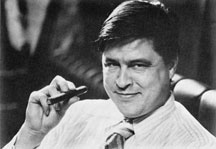
FGF E-Package
The Reactionary Utopian
December 30, 2014

Hollywood, Old and New
A classic by Joe Sobran
fitzgerald griffin foundation
[CLASSIC: 03/11/2004] — Hollywood today is notoriously anti-Christian and anti-Catholic, so much so that its current lords are vowing revenge on Mel Gibson for his colossal insolence in making a film about the Crucifixion without the conventional blasphemies. Worse yet, it’s a hit.
But this isn’t the Old Hollywood. The Old Hollywood is part of the reason I’m a Catholic today.
The Old Hollywood is part of the reason I’m a Catholic today.
When I was a boy, Hollywood, though dominated by Jews, treated Christianity with reverence and endowed Catholicism with a special charm and glamour. Part of the reason, of course, was commercial: America was chiefly Protestant, but with a large and growing Catholic population. Both kinds of Christians loved films about their religion, and they insisted that it be treated with respect.
The Old Hollywood was glad to oblige. If the profit motive dictated piety, well, good for the profit motive. Today it dictates far worse things. Yet Gibson, who risked his own fortune to make The Passion of the Christ, has shown that piety can still make money. This will no doubt produce a crisis of conscience in the New Hollywood.
In the Old Hollywood, many of the stars were Catholics: James Cagney, Spencer Tracy, Bing Crosby, Frank Sinatra, Irene Dunne, Loretta Young, and the popular director Frank Capra. Their devoutness varied, and many of them led irregular personal lives; but in their public conduct they usually honored religious norms. Setting a good example for children was an obligation everyone accepted. Humphrey Bogart might have a Scotch with his cigarette on the screen, but he watched his language.
That was a blessing for children like me. My parents were both lapsed Catholics, and I always joke that I was raised a lapsed Catholic; I wasn’t even baptized. But many of my relatives, friends, and neighbors were devout Catholics, and I always felt I was missing something. When my mother complained about her girlhood in a Catholic school, I secretly longed for the very experience she remembered with what seemed to me undue resentment.
… the collapse of Catholic leadership was surely a key reason for America’s moral disorientation.
In a word, Catholicism came to seem cool. To a teenager, that meant a lot. When John Kennedy ran for president in 1960, his religion was, for me, part of his appeal. Very superficial, of course, but superficial things matter. That was why we put such stress on setting a good example. Even we big brothers were expected to set a good example for our little brothers.
I earnestly studied the catechism and in 1961 was baptized. The priests I knew went far beyond setting a good example; they always found time to answer my countless questions with patience, charity, and clarity. Catholicism became more than “cool” for me; it was a great system of truths, harmonies, and mysteries, all centered on the supreme holiness of Christ, our ultimate good example.
Nobody suspected that within a decade, almost immediately after the Second Vatican Council, “sympathy for the devil” would come to seem cool, and the bishops of the Catholic Church would abandon their mission so far as to allow homosexuals to dominate the seminaries. The Protestant churches and the New Hollywood would follow suit, not only forsaking but attacking the old standards. It’s hard to say which caused what, but the collapse of Catholic leadership was surely a key reason for America’s moral disorientation.
Catholicism … was a great system of truths, harmonies, and mysteries, all centered on the supreme holiness of Christ, our ultimate good example.
Catholicism ceased to exert a gravitational pull on popular culture, and even on other forms of Christian piety; the rest was inevitable. The New Hollywood felt it had nothing to fear from Catholic criticism, which had become nugatory.
Gibson’s film is often attacked for seeming to revert to pre-Vatican II Catholicism. But in a way, it also marks a reversion to the Old Hollywood, while ironically exploiting the violence licensed by the New Hollywood for purposes the new moguls detest.
Martin Scorsese has already given us the New Hollywood’s Christ, not even a good example for kids, which would have been impossible before Vatican II. But the Old Hollywood’s image of Christianity was always sentimental and treacly, so Gibson has given us an image both pious and unflinching. The partisans of the New Hollywood don’t know how to categorize it except in the crude psychosexual terms of sadism and masochism.
Neither term fits, of course, but somehow people who don’t believe in Christ still devoutly believe in Freud, one of the last century’s quack messiahs.
The Reactionary Utopian archives
Copyright © 2014 by the Fitzgerald Griffin Foundation. All rights reserved. This column was published originally by Griffin Internet Syndicate on March 11, 2004.
Joe Sobran was an author and a syndicated columnist. See bio and archives of some of his columns.
Watch Sobran's last TV appearance on YouTube.
Learn how to get a tape of his last speech during the FGF Tribute to Joe Sobran in December 2009.
To subscribe to or renew the FGF E-Package, or support the writings of Joe Sobran, please send a tax-deductible donation to the:
Fitzgerald Griffin Foundation
344 Maple Avenue West, #281
Vienna, VA 22180
1-877-726-0058
publishing@fgfbooks.com
You may also subscribe or donate online.
@ 2025 Fitzgerald Griffin Foundation